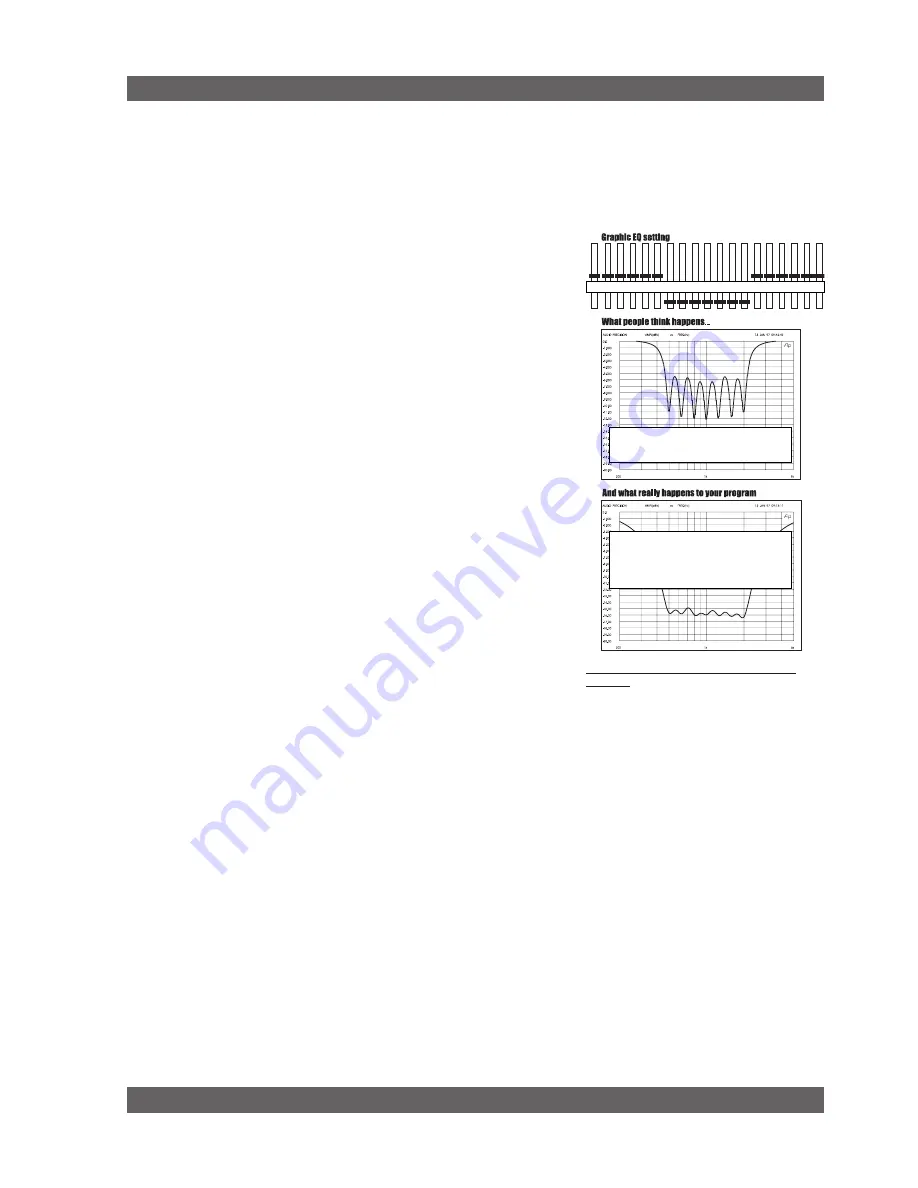
51
Sabine Smart Spectrum
®
Wireless
LIT-SWM6-7000-OG-EN-110203.indd
© 2011 Sabine
, Inc.
15. FBX THEoRY & PRACTICE
15.1. Introduction to FBX®
WHY FBX? Feedback is certainly the most pervasive challenge to the audio
industry. The potential appearance of sudden, loud, out-of-control feedback is
every sound engineer’s and musician’s nightmare. Unlike more subtle audio qual-
ity problems or shortcomings, feedback is embarrassingly obvious — it disturbs
the performer, the audience, and the technician, and can damage equipment
and just generally ruin your day.
Feedback is a potential problem in any amplified sound system that places a
microphone or pickup in proximity to a loudspeaker. Poor acoustical conditions
or misguided use by unsophisticated sound system operators only aggravate the
situation. To make matters still worse, a non-Sabine variety of wireless microphone
adds yet another level of feedback danger to the picture. Since feedback erupts
whenever the distance, location, and gain relationships between a speaker and
a microphone reach a critical combination, a mic that can move anywhere results
in an ever changing potential for feedback. A step in the wrong direction may
change a clear sound to a piercing shriek in less than a second.
This enhanced potential for feedback with a wireless system gets worse if lavalier
microphones are used. Such microphones are usually placed farther from the
mouth than handheld or head set microphones, thus requiring more gain. Also,
the polar pattern of a lavalier microphone is frequently omnidirectional. Thus,
the likelihood of feedback increases, due to the microphone’s increased off-axis
sensitivity to the sound emanating from the loudspeakers.
The Sabine True Mobility® SWM wireless systems solve feedback problems by
precise attenuation of very narrow bands of feedback-prone frequencies. The
process is automatic, simple to use, adaptable to changing acoustical conditions
and relationships, powerful in its application, and has minimal consequences to
the audio fidelity of the signal. We call this automatic filter an FBX Feedback
Exterminator® filter, or FBX filter for short.
15.2. The Advantages of FBX Filters
Before the invention of FBX, the most common device for controlling feedback
was the 31-band graphic EQ. However, an FBX filter offers three distinct advan-
tages over graphic filters.
1. First and most obvious is the automatic nature of FBX filters. When feedback
occurs, FBX responds more quickly than even the most experienced engineer.
Automatic FBX placement works even in the presence of audio program
material, intelligently distinguishing feedback from music or speech.
2. A second advantage is that FBX micro-filters are precisely placed anywhere
feedback occurs (with 1 Hz resolution), while graphic EQ filters are limited
to 31 fixed center points. An FBX filter represents a direct hit on feedback!
In contrast, a graphic EQ filter can only approximate the exact frequency of
the feedback, and the filter (or filters) with the closest center frequency must
be pulled down. Such filters are deepest at their centers, and such imprecise
attenuation takes a big (and unnecessary) chunk out of your sound (see Fig.
15a).
3. Increased clarity and gain-before-feedback are further accomplished by the
third and most important advantage of FBX: Sabine’s micro-filters are ten
times narrower than 31-band EQ filters. Using FBX micro-filters will return
up to 90 percent of the power removed by EQ filters.
Here’s a good place to make a very important distinction. Graphic EQ filters
are typically called “1/3-octave,” but it’s important to understand that this term
refers to the spacing of the filter centers (1/3-octave apart), and not the width
of the filter (usually a full octave). Graphic filters thus overlap one another, and
affect frequencies well above and below the center point frequency, including
frequencies of adjacent bands. This makes graphic equalizers very practical tools
for shaping sound “with broad strokes,” such as dialing in overall system EQ,
but results in destructive audio quality overkill when they are used to eliminate
feedback. A graphic equalizer would need more than 10,000 narrow-band sliders
to be as precise and powerful as your FBX.
-10 dB cut at 500, 630, 1K, 1.25K, 1.6K & 2K Hz
If the graphic EQ really had 1/3 octave filter
widths, the frequency response curve would
vary 6 dB between sliders. This would ruin
Graphic EQs usually use one-octave-wide
overlapping filters that provide much smoother
frequency response curves. Notice that the over-
lapping filters add together to cut -16 dB when
the sliders are only pulled down -10 dB.
Fig. 15a What a Graphic EQ does to your
Program
FBX Theory & Practice
Содержание SWM6000
Страница 2: ......














































